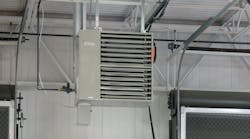By Jamie Tuinstra
You know those heaters that blast you with warm air when you stroll into a store during the winter? Those are unit heaters, but they can serve many more uses aside from enticing and warming Christmas shoppers.
They can heat a greenhouse. They can heat a detached garage. They can heat a manufacturing facility. They can even heat a large man cave – all without the expensive ductwork or costly installation that comes with standard furnaces.
In the simplest of terms, unit heaters are boxes that provide heat via natural gas or propane. A propeller fan supplies air flow over a heat exchanger that blows into the space you want heated. They are efficient and compact – a lot of heat in a small box -- but depending on the application, they can approach 400,000 BTUs.
A big benefit of unit heaters is that they come without the installation cost of a standard gas furnace, which must be anchored to the floor and require relatively extensive ventilation. Unit heaters are literally hung from a wall or ceiling, require a single horizontal or vertical ventilation tube as an outlet for combustion byproducts and flue gases. Some popular models operate at about 80 percent, so there’s no condensate to collect and a single-wall vent is all that’s needed. The heaters must be installed by a certified contractor, but once a voltage line is run to a thermostat, it’s done and ready for use.
The low installation cost and savings are augmented by their efficiency. The standard unit heater, heating indoor air, is at least 80 percent efficient, but some models are up to 97 percent efficient. Some basic calculations, including square footage and heat loss, must be performed to determine the best unit and BTUs for any chosen application, but their use can indeed range from a garage to a large warehouse or manufacturing facility. The latter applications typically involve a series of heaters to provide redundancies in a commercial setting.
And, again, these units are quite versatile when compared to a boiler or furnace. They can be vented both vertically or horizontally, so ventilation can be via wall or roof. Unit heaters are affordable, depending on the size, power or efficiency, but most models start at about $1,200. Their relative lack of moving parts makes maintenance and cleaning much easier than a standard HVAC system.
A typical unit heater has a lifespan of about 15-20 years, depending on its use. One thing to keep in mind: If it is being used in a manufacturing facility that uses caustic or corrosive substances – or is used in an indoor pool setting that might contain a lot of aerosolized chlorine – its lifespan may be less. There might be better alternatives for such spaces. There are models made specifically for the humid confines of greenhouses, for instance, that feature stainless-steel air handlers.
It could be said the original unit heater was a wood stove, and some are still used. But oil, and then propane, natural gas and electricity became the obvious – and more efficient – fuels of choice for unit heaters. There are even thermal, water-based heaters on the market today. Most oil unit heaters have long been converted to natural gas or propane, but there is still demand for such in the Dakotas and Canada. Those are a dying breed, but they are still in demand.
Unit heaters continue their attractiveness in efficiency and simplicity, and high-efficiency units are gaining in popularity, especially in colder climates or during very cold winters.
Propane and natural gas are now the preferred fuel source for these highly efficient, versatile, cost-effective heaters that provide a lot of efficiency bang for the buck. They are indeed a lot of heat in a small box.
Unit heaters offer value to your customers because they are highly efficient, easy to maintain, cheap to install and can bring heat to detached buildings or other out of the way places without breaking the bank.
Jamie Tuinstra is product manager for Modine Manufacturing Co., Racine, Wisconsin.








